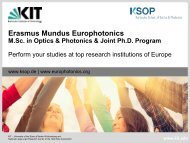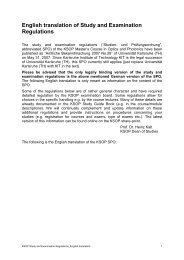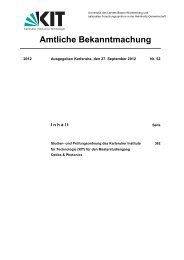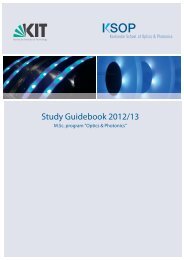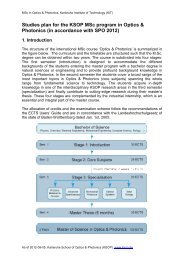Lab Descriptions - Karlsruhe School of Optics & Photonics - KIT
Lab Descriptions - Karlsruhe School of Optics & Photonics - KIT
Lab Descriptions - Karlsruhe School of Optics & Photonics - KIT
Create successful ePaper yourself
Turn your PDF publications into a flip-book with our unique Google optimized e-Paper software.
observe the dis- and reappearance <strong>of</strong> (quantum) interferences for certain<br />
combinations <strong>of</strong> light polarization.<br />
4. Semiconductor spectroscopy (Department <strong>of</strong> Physics) (2 lab units)<br />
By polarization-dependent measurements <strong>of</strong> absorption and transmission spectra<br />
<strong>of</strong> several two- and three-dimensional semiconductor structures it is possible to<br />
extract information <strong>of</strong> the nature <strong>of</strong> semiconductors, e.g. excitons, energy gap,<br />
dimensions, refractive index.<br />
5. Solar Cells (Department <strong>of</strong> Physics) (2 lab units)<br />
Silicon solar cells are analyzed by measuring characteristic curves and efficiency<br />
factors. The students will get an insight into pn-junctions, semiconductor optics<br />
and global energy problems.<br />
6. Laser resonator (Department <strong>of</strong> Physics) (2 lab units)<br />
This lab provides an introduction into optical lab work, the use <strong>of</strong> optical<br />
components is introduced. In particular, a Titan:Sapphire laser is adjusted to<br />
make it lase. Different spectra are taken and its use and application are worked<br />
out.<br />
7. Magneto-optical Kerr effect – MOKE (Department <strong>of</strong> Physics) (2 lab units)<br />
Measurement <strong>of</strong> the magnetization <strong>of</strong> thin films and heterostructures by the<br />
MOKE is from great importance for magneto-optical data storage. Polarization<br />
and refraction <strong>of</strong> light, the Kerr-effect and magnetism are the key terms <strong>of</strong> this<br />
course.<br />
8. Zeeman effect (Department <strong>of</strong> Physics) (2 lab units)<br />
The Zeeman effect <strong>of</strong> Helium atoms is measured with a grating spectrograph.<br />
Fundamental aspects <strong>of</strong> atomic physics are examined in this course, e.g.,<br />
selection rules, g-factor, atom-light-interaction, magnetic quantum number.<br />
9. Fabry-Perot interferometer (Department <strong>of</strong> Physics) (2 lab units)<br />
A Fabry-Perot interferometer allows the determination <strong>of</strong> optical spectra with very<br />
high resolution. The hyperfinestructure spectrum <strong>of</strong> Tl 205 is measured with high<br />
accuracy considering the dispersion <strong>of</strong> the spectrometer.<br />
10. Optoelectronics laboratory (Department <strong>of</strong> Electrical Engineering and<br />
Information Technology) (8 lab units)<br />
This is a series <strong>of</strong> four labs:<br />
a. Light Measurement: The light measurement laboratory will deal with the<br />
measurement <strong>of</strong> light intensity distribution, luminous flux and different<br />
reflector types. These measurements are typically used to evaluate the<br />
performance <strong>of</strong> luminaries.<br />
b. <strong>Optics</strong> on the Nanoscale: The laboratory is concerning with the<br />
theoretical basics and experimental techniques <strong>of</strong> nanoscale optics like<br />
optical antennae. A laser safety instruction is required.<br />
c. Compact fluorescent lamps: Compact fluorescent lamps are operated<br />
on an electronic gear (ballast). Properties <strong>of</strong> the lamp as well as those<br />
<strong>of</strong> the ECG are measured, i.e. real and reactive power as functions <strong>of</strong><br />
2



